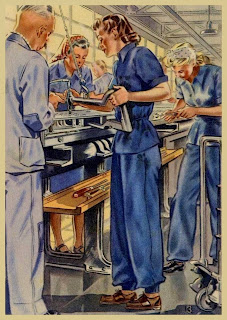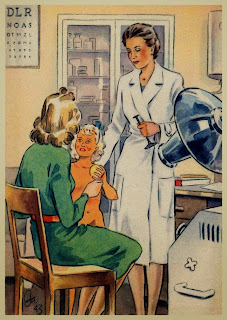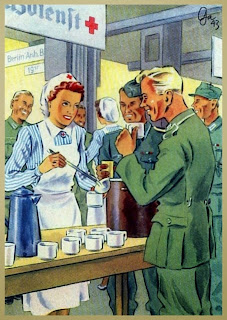According to Penny Colman one of the most dramatic
changes during World War II was the number of women who went to work. As the
armed forces filled its ranks with manpower, industry filled its jobs
with womanpower.
Because of the
absence of many men who either joined the military or took jobs in war
production industries, some women moved outside their traditional roles and
took positions in jobs usually reserved for men.
Germany was
ruled by the same conditions. By 1945, German women were holding 85% of the
billets as clericals, accountants, interpreters, laboratory workers, and
administrative workers, together with half of the clerical and junior
administrative posts in high-level field headquarters.
Like other
country's there was propaganda who focused on the female worker. Erich Gutjahr
Bildverlag at Berlin was a publisher who issued 20 postcards with drawings of three
different painters: Hahmeyer, Becker and Gagelmann. The serie was titled 'Frauen
schaffen für euch" (Women working for you).
Hahmeyer
Not much is known of Eva Hahmeyer. She was an illustrator of various books. In this case the subject was a postcard of a NSV-woman.
The
Nationalsozialistische Volkswohlfahrt (NSV), meaning "National Socialist
People's Welfare" was a social welfare organization during the Third
Reich. The NSV
became established as the single Nazi Party welfare organ in May 1933. One of
the special fields was "Mother and
child".
|
|
Becker
It is almost certain that Becker came from a famous artist family. But that is all.
Picture no. 667 shows a DRK-woman. DRK means Das Deutsche Rote Kreuz (Red Cross). Following Hitler's takeover of the government in Germany in January
1933, the NSDAP (Nazi Party)
moved to control the Red Cross. Thus the DRK became a legally recognized
organization of the NSDAP in December 1937. Finally, at the end of 1938 the
German Red Cross officially came under the control of the Ministry of the
Interior's Social Welfare Organization, becoming de facto a Nazi entity.
|
|
|
|
|
|
|
|
Gagelmann
Gert Gagelmann was known for his illustrations for fashion-magazines. But with proud breasts and high heels Gagelmann pushed the woman a little bit further than only fashionable.
Update: February 2016
Till now
I was not aware of the existence of a considerable, unsigned, collection off erotic drawings contributed to "Julie
Delcourt" or "German". Warning: the link provided contains explicit
sexual content:
There is
discussion whether Gagelmann could be the unknown artist of these unsigned
drawings. In my opinion the postcards and the drawings show indeed an astonishing
similarity. In my 2014 blogpost I made the observation that Gagelmann pushed some women a little bit further than only
fashionable. That meant that Gagelmann in my opinion was well aware of the sexual
component which could be added to a, ad first glance, ordinary scene. If it
turns out that Gagelmann is indeed the unknown artist I can not say that I
would be surprised.
|
|
|
|
|
|
|
|
|
|


































